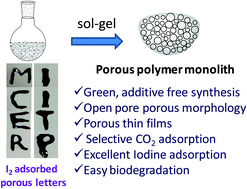Degradable and processable polymer monoliths with open-pore porosity for selective CO2 and iodine adsorption†
Abstract
A task-specific design of biodegradable and processable porous polymers is one of the primary requisite for their efficient day-to-day use to minimize polymer waste. Herein, a surfactant (or additive)-free method is reported for the synthesis of a processable and degradable aliphatic open-pore porous polyelectrolyte monolith for the removal of gaseous pollutants such as iodine and CO2. This is achieved via a colloidal templating method. In the 1st stage, cationic colloidal nanoparticles containing reactive amines and acrylamide groups were formed via the phase separation of hyperbranched polyaminoamides in water (sol). These cationic nanoparticles (which acted as both templates and macromers) further reacted to form a gel, which upon freeze-drying leads to the formation of a polymer monolith with an open-pore porous morphology and hierarchical porosity throughout its structure. During gelation, the shape of the monolith can be controlled using suitable templates and a similar strategy was used to prepare porous thin films. The monolith has shown excellent iodine adsorption ability (5000 mg g−1 in the vapor phase and 2663 mg g−1 in the solution phase) with good reusability and CO2 adsorption ability (60 mg g−1), with CO2/CH4 and CO2/N2 selectivities of 18.5 and 6.7, respectively. The degradability of the materials was studied in detail at different pH, confirming their easy degradability in aqueous solutions and a higher degradability at basic pH.



 Please wait while we load your content...
Please wait while we load your content...